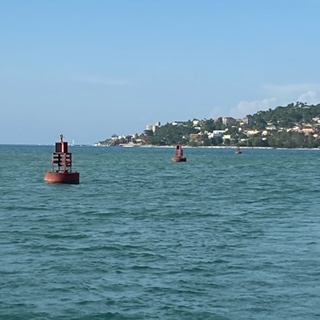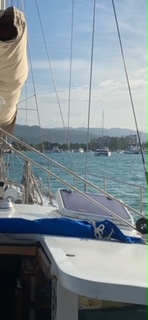Montego Bay

Dawnbreaker
Lars Alfredson
Sun 1 May 2022 22:46
About: And a 10 minute taxi ride will take you to the Montego Bay arts and craft market. This is a “DON’T MISS.” It is colorful, it is large, and it is very safe. You can shop for an entire day and not see everything. The Harbor Street Crafts Market consists of an enclosed lot with numerous wooden buildings in it. Each building has many merchants selling a wide variety of arts and crafts. Don’t be afraid to bargain, but try to remember that you are getting about 85 Jamaican dollars to 1 US dollar. The people who work there work long hours and you will clearly see that they work very hard. They want you to purchase something and they want you to be happy with it. When you walk into their booth, if it is a hot day, the owner will stay behind you waving a fan while you look. The key to getting a good price is to smile and to keep the negotiations within context. If you are looking at a shirt for $15.00 US and offer $2.00 US, the chances are you will not end up owning it. You must be realistic. Think 20 to 30% off the asking price. As the large cruise ships do not bring their groups to the market en masse, you will get the distinct feeling that your business is veryappreciated. You might even say, “A shopper’s paradise.” One of the many booths at the “Harbor Street Crafts” The center of the town of Montego Bay is interesting and has a great deal to offer. Be careful walking, for while it is safe, you will be approached by “guides, salesmen and others” who have something to offer you. Many times they will tell you they recognize you and strike up a conversation. As they walk alongside you, they automatically assume that you have hired them. The town square is referred to as SAM SHARPE SQUARE. Sam Sharpe was a slave who led the famous “Christmas Rebellion” in December 1831. SAM SHARPE SQUARE Not too far from the square is the open market where you can purchase all types of food stuffs. What really “shines” is FRUITS AND VEGETABLES and you will find the prices very reasonable. Everything you ever imagined that looks and tastes good is sold fresh each day. There are enormous mangos, succulent watermelons and eye-popping bananas and papayas. And vegetables that are so large and so colorful, they do not look real. Further on and also close by is the “HIP STRIP” on Gloucester Avenue. This is where the action is. It is fabled to have anything that a tourist could want. The walk along the Hip Strip is a joy in itself as it bursts with activity and life. There is a lavish assortment of restaurants here that caters to many different palates and offers a wide range of ethnic foods. You will find everything from Red Stripe beer, to "We Be Jammin" and "Life's a Beach" T-shirts, to crafts of wood or seashell art. There are also many fine-jewelry merchants and duty-free items. Haggling is fairly easy with sidewalk vendors, who are simply happy you stopped by. American dollars are preferred here. Jimmy Buffet’sMARGARITAVILLEon the “hip strip” You need travel only 7 miles northeast of Montego Bay on the North Coast Highway to step back into the sugar cane plantation and slave history of Jamaica. The 18thcentury Georgian mansion, Rose Hall Great House, is considered the most impressive of Jamaica’s former plantation houses. It boasts an equally impressive back story as the home of the White Witch, Annie Palmer. Orphaned at 11 in Haiti when her English-Irish parents died of yellow fever; reared till 18 by her Vodoun practicing nanny and then orphaned again; Annie crossed to Jamaica and married John Palmer and became mistress of Rose Hall Plantation which comprised about 10 square miles and required 2000 slaves to operate.

